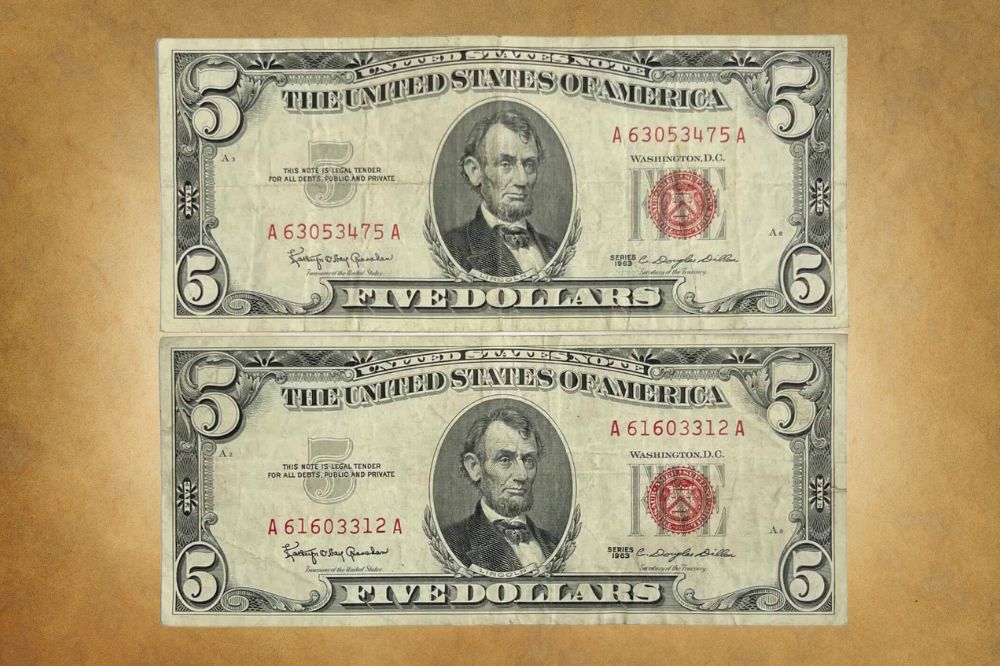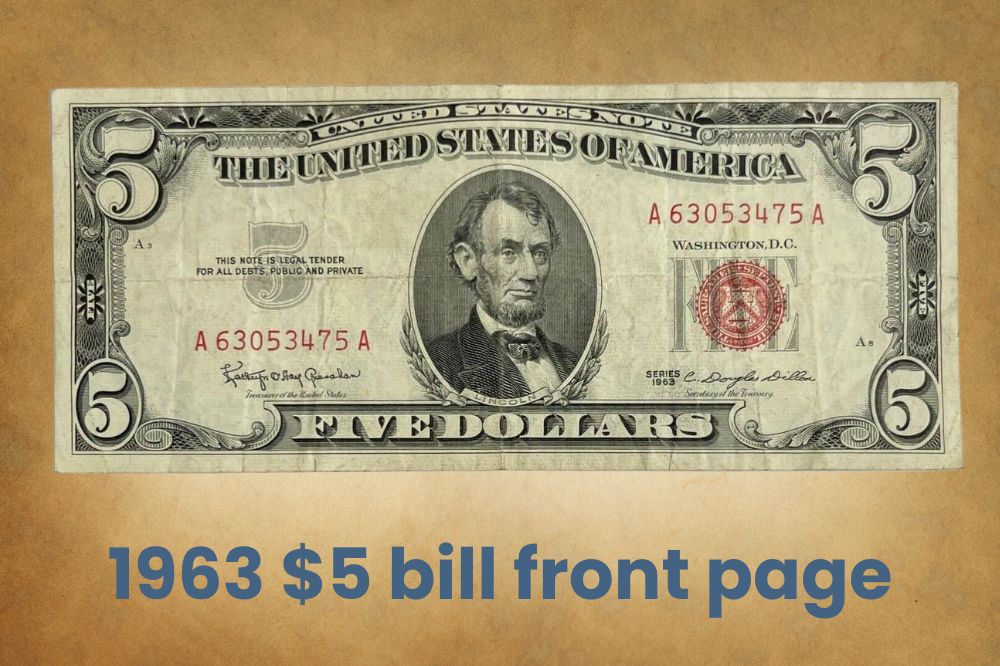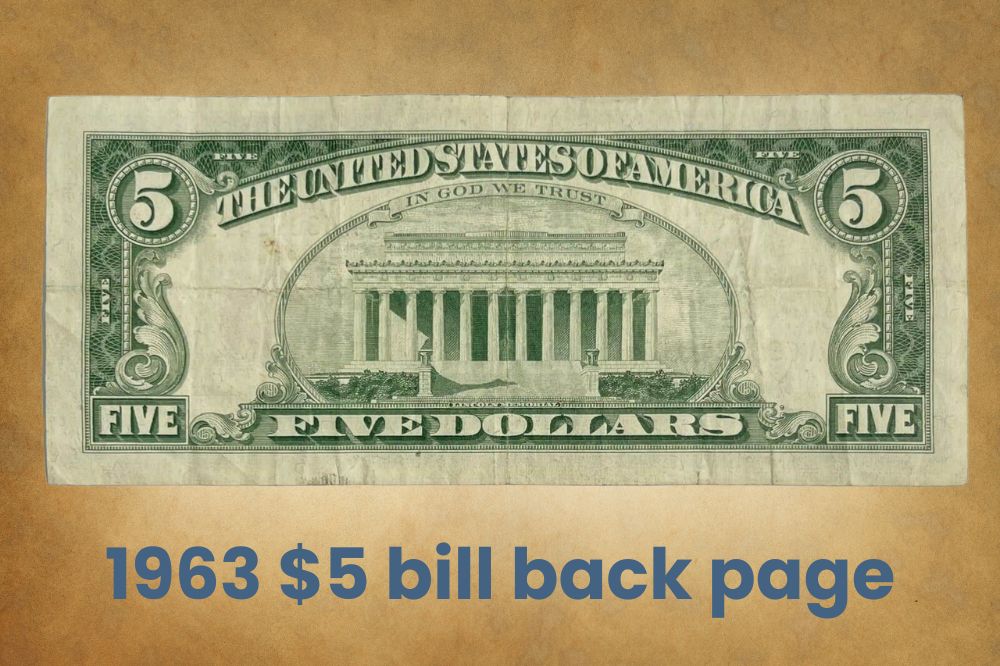1963 $5 Bill Value Guides (Red ink & Green ink Series)

The $5 banknote series is the first with the motto IN GOD WE TRUST on the back page and the last one with the red seal. You can recognize three types of these banknotes. This particular bill has 16th American President Abraham Lincoln’s portrait on the front page, while the Lincoln Memorial is on the back page’s center.
Besides the one with a red seal, there are also two varieties with a green seal. As you can guess, the 1963 $5 bill value will depend on this feature. Collectors always look for banknotes with a red seal, and their value is typically higher, particularly if it comes with a rare or specific serial number.
1963 small size $5 bill value |
|||
| Series | Bills in uncirculated condition | Bills in circulated condition | Bills with a star (★) |
| *by Variety & Errors | |||
| 1963 with a red seal | $15 | $5 to $9 | $20 |
| 1963 and 1963 A with a green seal | $10 to $20 | $5 to $6 | $25 to $35 |
| *by Silver Reciclers | |||
| 1963 with a red seal | $25 | $13.50 | $22.50 to $90 |
| *by Old money Prices | |||
| 1963 with a green seal | $12 to $20 | $5 to $8 | $30 to $40 |
| *by USCA | |||
| 1963 with a red seal | $18+ | $5 to $7 | / |
| 1963 and 1963 A with a green seal | $18+ | $5 to $7 | / |
1963 $5 Bill Value Guides
The primary thing when defining the 1963 $5 bill is its condition. Having an uncirculated or worn-out banknote sometimes means the difference in tens or hundreds of dollars. However, their price also depends on a few factors, such as:
- Popularity
- Seal type
- Rarity and demand on the market
- Rare or atypical serial number, particularly Serial Number 00000001
- Provenance
1963 $5 bill types |
|||
| Features | 1963 $5 bill | 1963 $5 bill | 1963 A $5 bill |
| Type | US (Legal Tender) note | Federal Reserve note | Federal Reserve note |
| Seal | Red | Green | Green |
| Variety | One | Ten | Twelve |
| Star variety | One | Ten | Twelve |
| First delivery date | 2nd March 1964 | 16th September 1964 | 7th June 1965 |
| Last delivery date | 27th November 1967 | 15th July 1965 | 9th September 1969 |
1963 $5 United States (Legal Tender) note
The US Bureau of engraving and printing produced five-dollar bills with a red seal in:
- 1928 (plus those from A to F)
- 1953 (plus those from A to C)
- 1963
It is estimated that over 63 million such banknotes were printed in 1963. You can find only one Legal Tender (US note) type, which average price is $6 to $25, depending on the condition. Pieces with a star are more expensive, and you can expect to get $22.50 to $90 for such a banknote.
1963 $5 Federal Reserve note
Ten banks (with the determined number and letter designation) issued 1963 $5 bills with a green seal and those with star serial numbers. Banks in Minneapolis and Richmond didn’t have a share in this banknote printing, so only serial numbers with ten different first letters were available on the market.
Banknotes with a green seal are typically worth their face value, but those in uncirculated condition can cost $12 to $20, depending on the dealer. As always, banknotes with a star are more pricey, and one can cost $30 to $40, depending on the condition.
1963 A $5 Federal Reserve note
All twelve banks (with the determined number and letter designation) issued 1963 A $5 bills with a green seal. Therefore, you can buy any of the twelve standard varieties and the same number of corresponding banknotes with star serial numbers.
As expected, the 1963 A $5 bill is less expensive than the 1963 $5 bill, and you should set aside about $10 for one.
1963 $5 Bill Errors
Even though people believe that old error banknotes are more valuable than modern pieces, it is actually quite the opposite. Since control is more strict nowadays, error bills are scarce and consequently more expensive.
Errors have been rare in banknotes from the beginning, but collectors occasionally find those with an altered digit in the serial number or some printing imperfections. However, you can rarely discover bills produced in 1963 with significant errors.
Therefore, collectors pay particular attention to specific and rare serial numbers and collect such banknotes instead of error pieces.
History of the 1963 $5 Bill
The National Currency Act that was passed in 1863 allowed the first large-size $5 bill printing. These Legal Tender notes in excellent condition are highly collectible nowadays.
You can recognize three modern $5 bill types printed from 1928 to 1963, but all had President Abraham Lincoln on the front page. In the past, Americans nicknamed this bill the FIN, after the German Yiddish word for the number five. However, this term is a bit outdated in modern society.
Nowadays, $5 bills make up 6% of totally printed American paper currency. Unlike other American banknote denominations, these banknotes valuing 500 cents have existed in three versions:
- United States (Legal Tender) notes that were printed in 1928 for the first time and repealed in 1967
- Silver Certificates appeared in 1934 for the first time and were abolished in 1967
- Federal Reserve notes that occurred in 1928 for the first time, and all $5 bills produced since then are in this group
All specimens appearing in circulation in 1963 were printed in Washington DC, and you can recognize:
- Legal Tender notes with a red seal
- Federal Reserve note 1963 and 1963 A with a green seal
Since 1963 $5 bills are the last series with a red seal, collectors highly appreciate them. On the other hand, modern versions with the same date but green seal are abundant and not collectible.
Features of the 1963 $5 Bill
The 1953 $5 bill with a blue seal was the last Silver Certificate series printed. By the 1960s, it was possible to exchange these bills for silver.
The US Bureau of engraving and printing produced 63 million $5 bills with a red seal and four million star banknotes in 1963. As I have already mentioned, you can also find 1963 and 1963 A banknotes with a green seal, but they are less valuable and collectible.
The front page of the 1963 $5 bill

The front page design includes the 16th American President Abraham Lincoln’s image with his name below. The red treasury seal is on the right side, while the sizable digit FIVE is on the left with an overprinted note.
You can see two identical serial numbers in the upper right and lower left corners, while the banknote’s lower part is reserved for the treasury secretary and treasurer’s signatures.
The back page of the 1963 $5 bill

The 1963 $5 bill with the red seal was the first banknote with the inscription IN GOD WE TRUST above the Lincoln Memorial. It was positioned centrally inside the vignette on the back page. It is below THE UNITED STATES OF AMERICA placed along the top edge, while the denomination FIVE DOLLARS is placed at the bottom.
The number five is placed in the upper two corners, while the lower two are reserved for the denomination written in letters.
1963 $5 bill |
|
| Face value | $5 |
| Number printed | Over 63 million with a red seal and 4 million star notes |
| Type | 1963 Legal Tender Note (US note) |
| 1963 Federal Reserve note | |
| 1963 A Federal Reserve note | |
| Producer | The US Bureau of engraving and printing |
| Printing place | Washington DC |
| The front page | The 16th American President, Abraham Lincoln |
| The back page | The Lincoln Memorial |
| Material | 75% cotton and 25% linen |
| Series | One with a red seal and two with the green seal |
| Bill height | 2.60937 inches (66.28 mm) |
| Bill width | 6.14062 inches (156 mm) |
| Bill weight | 0.03527 ounces (1 g) |
| Seal variety | Red or green |
| Shape | Rectangular |
| Security features | Red and blue security fibers and raised texture |
Other features of the 1963 $5 bill
The rectangular 1963 $5 bill is made of cotton and linen and comes with a red or green seal. This banknote weighs 0.03527 ounces (1 g). Its height is 2.60937 inches (66.28 mm), and its width is 6.14062 inches (156 mm).
Type
You can recognize three types printed this year, one 1963 $5 bill with a red seal and two varieties, 1963 and 1963 A, with a green seal.
Seals
The red treasury seal with a specifically designed toothed edge is positioned on the right. Besides this variation, you can recognize two bill types with a green seal at the same place. Plus, they have an additional black Federal Reserve bank seal left of the President’s portrait.
Serial number
Each 1963 $5 bill has a serial number printed on two places on the front page. They contain two letters, excluding Z, used for test printing, and O because it is too similar to zero and may cause confusion.
The first letter refers to the Federal reserve bank that produced this particular bill, and the line of eight digits follows it. In some cases, a star replaces the letter when the banknote is defective and inappropriate for circulation.
The star replaced the first letter on Legal Tender notes, while Federal Reserve notes have the star instead of the last letter. Since the law forbids printing two banknotes with the same serial number, these bills are necessary to keep the required note number in the series.
In the past, the star note was printed instead of the 100,000,000th bill in a series. However, it is not a practice in modern times, when their number only shows how many defective banknotes are in each series.
Signature
1963 with a red seal
- Treasury Secretary Clarence Douglas Dillon
- Treasurer Kathryn Elizabeth Granahan
1963 with a green seal
- Treasury Secretary Clarence Douglas Dillon
- Treasurer Kathryn Elizabeth Granahan
1963 A with a green seal
- Treasury Secretary Henry Hammill Fowler
- Treasurer Kathryn Elizabeth Granahan
Printing
All US currency is made with raised printing you can feel under the finger. Such a unique texture protects banknotes from counterfeiting and shows you that you have a genuine bill in your hands.
Paper
Most people tend to call banknotes ‘paper money,’ but that is far from the factual situation. All American notes, including 1963 $5, are printed on a material made of cotton with 25% added linen. Besides, you can see red and blue security fibers that secure them against unauthorized printing attempts.
FAQ about the 1963 $5 Bill
What makes a 1963 $5 bill rare?
Standard 1963 $5 bills are abundant nowadays, but a few pieces can be scarce and valuable. For instance, particular serial numbers are rare, making a bill containing one highly desirable and collectible.
Which 1963 $5 bill is worth a lot of money?
Manu Americans believe that old $5 bills are valuable, but it is not always the case. A few rare and unique 1963 $5 bills can be worth thousands of dollars, unlike practically worthless 1800s pieces in low condition. Let’s take a look.
- 1963 $5 bills with a red seal in a gem crisp uncirculated condition (an original pack of 100 pieces with a star) are worth $13,200
- The 1963 $5 bill with a red seal in a choice uncirculated condition is worth $4,600
- 1963 $5 bills with a red seal in a gem crisp uncirculated condition (an original pack of 100 pieces with a star) are worth $4,320
- 1963 $5 bills with a red seal in a choice crisp uncirculated condition (an original pack of 100 pieces) are worth $3,840
- 1963 $5 bills with a red seal in a gem crisp uncirculated condition (an original pack of 100 pieces) are worth $3,818
How much is the 1963 $5 bill worth?
You can get about $20 to $25 for one banknote printed in 1963, but only when it is in uncirculated condition. The used bills’ price is about $10.
Are there any rare 1963 $5 bills?
The 1963 $5 bill is not particularly rare on the current currency market, but you can win a jackpot with the one featuring a rare serial number. Such a piece is collectible and can be worth hundreds, sometimes even thousands of dollars.

Yo tengo uno de 5 en rojo
I am very interested in these bills.
Hi,
I have a 1963A with the name Fowler as the Secretary of the Treasury.
It has a green seal and serial number ends in 414.
It’s circulated but in good condition.
Anyone know the value?
Thank you!
Beth
What is the value if you had a $5 bill with a red seal with the star in the middle dated 1953
I would like to know how much a $10 bill is without in God we trust printed on it
We have one don’t no what’s it’s worth five dollars bill
What is the value f a twenty dollar with little star.
I had one and told a boyfriend to hold it for me. When I asked for it back he said he spend it on gas I know he was a lie. I still have old coins and $2 bill so I’m still collecting there’s a sad thing when someone that you trust steal something from you.
The older 1928 and 1952 $2 bills w. Red stamps worth
I have 1$ blue seal and I have plenty more I will like to know more I want to sele it, thank
I have 4 RED print $2 bills 1 of them is a star note All of them are from 1928 I don’t know how to see what’s it’s worth the one place I went to tried to knock the star over the counter to switch it out ! What can I do or where to go I’m in California in the Bay Area
That star note 2 dollar bill is but from ya if was right price
Look on chrome search engine for a money chart and insert the year and etc..
Look on r rare money for the kind and type of currency the value and condition got in common words it should be the very 1st site that shows
So your saying the rare 5$ notes are accounted for or they are not there in circulation ,also Dillon interest,how does that work ¿
Particularly rare on the current currency market, jackpot rare serial numbers ,need playing tel sla Tesla broke bankrupt talk about a jackpot since where on the subject of jakepots federal gaming#25 talks about rules ,regulations in a casino,serial #s to the rare four 5 notes since they where handed from casino hands to mine
Hello I have a lot of of coins and silver certificate bills ,can you give the best place to go to see how much they are worth,I am in Phoenix,AZ . I took a my 1914 silver penny to one place and I believe the lady trade it for a copper one.
I have one 5dollar bill from 1953A, two 2dollar bills1976A andB, and 2 one dollar bills with blue seal one is 1957A and the other is 1957.The 5dollar bill has a blue seal.I have one half dollar that is a Bicentennial.Thanks.
I have a red seal 5.00 bill, i would like to see how much I can get for it, It starts with A202 serial number.
I have a five dollar bill with a blue sill . Is it worth anything?
I have a red 5 dollar bill serial number starts with A 56070727A
Yes, I have a five dollar red seal bill. Serial number is a 501807038 is a 1963.